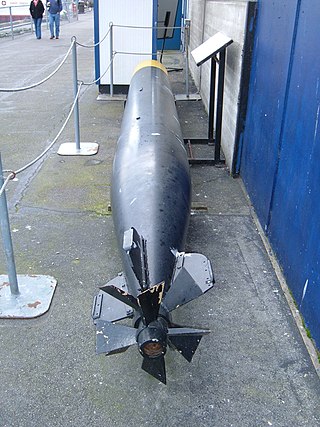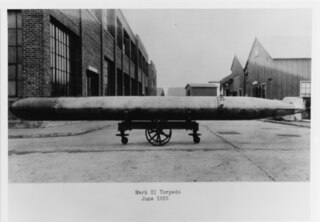
The RUR-5 ASROC is an all-weather, all sea-conditions anti-submarine missile system. Developed by the United States Navy in the 1950s, it was deployed in the 1960s, updated in the 1990s, and eventually installed on over 200 USN surface ships, specifically cruisers, destroyers, and frigates. The ASROC has been deployed on scores of warships of many other navies, including Canada, Germany, Italy, Japan, Taiwan, Greece, Pakistan and others.

A cruiser is a type of warship. Modern cruisers are generally the largest ships in a fleet after aircraft carriers and amphibious assault ships, and can usually perform several operational roles from search-and-destroy to ocean escort to sea denial.

A modern torpedo is an underwater ranged weapon launched above or below the water surface, self-propelled towards a target, and with an explosive warhead designed to detonate either on contact with or in proximity to the target. Historically, such a device was called an automotive, automobile, locomotive, or fish torpedo; colloquially a fish. The term torpedo originally applied to a variety of devices, most of which would today be called mines. From about 1900, torpedo has been used strictly to designate a self-propelled underwater explosive device.

A torpedo boat is a relatively small and fast naval ship designed to carry torpedoes into battle. The first designs were steam-powered craft dedicated to ramming enemy ships with explosive spar torpedoes. Later evolutions launched variants of self-propelled Whitehead torpedoes.

A PT boat was a motor torpedo boat used by the United States Navy in World War II. It was small, fast, and inexpensive to build, valued for its maneuverability and speed but hampered at the beginning of the war by ineffective torpedoes, limited armament, and comparatively fragile construction that limited some of the variants to coastal waters. In the US Navy they were organized in Motor Torpedo Boat Squadrons (MTBRONs).

The Type 93 was a 610 mm (24 in)-diameter torpedo of the Imperial Japanese Navy (IJN), launched from surface ships. It is commonly referred to as the Long Lance by most modern English-language naval historians, a nickname given to it after the war by Samuel Eliot Morison, the chief historian of the U.S. Navy, who spent much of the war in the Pacific Theater. In Japanese references, the term Sanso gyorai is also used, in reference to its propulsion system. It was the most advanced naval torpedo in the world at the time.

The Clemson class was a series of 156 destroyers which served with the United States Navy from after World War I through World War II.

The Wickes-class destroyers were a class of 111 destroyers built by the United States Navy in 1917–19. Together with the six preceding Caldwell-class and following 156 subsequent Clemson-class destroyers, they were grouped as the "flush-deck" or "four-stack" type. Only a few were completed in time to serve in World War I, including USS Wickes, the lead ship of the class.

The Mark 13 torpedo was the U.S. Navy's most common aerial torpedo of World War II. It was the first American torpedo to be originally designed for launching from aircraft only. They were also used on PT boats.

The Farragut-class destroyers were a class of eight 1,365-ton destroyers in the United States Navy and the first US destroyers of post-World War I design. Their construction, along with the Porter class, was authorized by Congress on 29 April 1916, but funding was delayed considerably. Limited to 1,500 tons standard displacement by the provisions of the London Naval Treaty of 1930, the ships were laid down beginning in 1932 and were completed by 1935. After 12 years since the last of the previous class of American destroyers was commissioned, the Farraguts were commissioned in 1934 and 1935.

The Bagley class of eight destroyers was built for the United States Navy. They were part of a series of USN destroyers limited to 1,500 tons standard displacement by the London Naval Treaty and built in the 1930s. All eight ships were ordered and laid down in 1935 and subsequently completed in 1937. Their layout was based on the concurrently-built Gridley class destroyer design and was similar to the Benham class as well; all three classes were notable for including sixteen 21 inch torpedo tubes, the heaviest torpedo armament ever on US destroyers. They retained the fuel-efficient power plants of the Mahan-class destroyers, and thus had a slightly lower speed than the Gridleys. However, they had the extended range of the Mahans, 1,400 nautical miles (2,600 km) farther than the Gridleys. The Bagley class destroyers were readily distinguished visually by the prominent external trunking of the boiler uptakes around their single stack.

The Mark 37 torpedo is a torpedo with electrical propulsion, developed for the US Navy after World War II. It entered service with the US Navy in the early 1950s, with over 3,300 produced. It was phased out of service with the US Navy during the 1970s, and the stockpiles were sold to foreign navies.

An aerial torpedo is a torpedo launched from a torpedo bomber aircraft into the water, after which the weapon propels itself to the target.

The Mark 14 torpedo was the United States Navy's standard submarine-launched anti-ship torpedo of World War II. This weapon was plagued with many problems which crippled its performance early in the war. It was supplemented by the Mark 18 electric torpedo in the last two years of the war. From December 1941 to November 1943 the Mark 14 and the destroyer-launched Mark 15 torpedo had numerous technical problems that took almost two years to fix. After the fixes, the Mark 14 played a major role in the devastating blow U.S. Navy submarines dealt to the Japanese naval and merchant marine forces during the Pacific War.

The Mark 18 torpedo was an electric torpedo used by the United States Navy during World War II. The Mark 18 was the first electric storage battery torpedo manufactured for the US Navy and it was designed primarily for use as a submarine-launched torpedo.
There have been a number of 21-inch (53.3cm) torpedoes in service with the Royal Navy of the United Kingdom.
The Whitehead Mark 5 torpedo was a Whitehead torpedo adopted by the United States Navy for use in an anti-surface ship role in 1910. The Mark 5 was the first torpedo to be manufactured by a foreign company, the Whitehead facility in the United Kingdom, and in 1908, by the Naval Torpedo Station in Newport, Rhode Island. It was also the first torpedo to allow the firing ship to vary the torpedo's speed and range.

The Mark 11 torpedo was the first American torpedo to be designed within the United States Navy without collaboration from industry. It was developed by the Washington Navy Yard in Washington, D.C., and the Naval Torpedo Station in Newport, Rhode Island. The Mark 11 torpedo was also the first to feature a three-speed setting capability while tube-loaded: high at 46 knots, medium at 34 knots and low at 27 knots. Due to stability problems it was supplemented by the Mark 12 torpedo within two years, which had a 44-knot high speed setting.
The Mark 33 torpedo was the first passive acoustic antisurface ship/antisubmarine homing torpedo intended for the United States Navy to employ a cast aluminum shell. It featured two speeds – high and low, and was meant to be launched from submarines and aircraft.

United States Navy submarines, surface ships, and aircraft launch torpedoes, missiles, and autonomous undersea vehicles as part of training exercises. Typically, these training munitions have no warhead and are recovered from the sea and reused. Similarly, new naval weapons under development are launched at sea in performance trials. These experimental units also need to be recovered, in their case to obtain evaluation data. At various points in history, newly manufactured torpedoes were fired as a quality control measure and these, too, had to be recovered before issuing them to the fleet. The U.S. Navy has used a variety of boats to accomplish the retrieval of these test and training munitions. As their missions evolved over the last century they have been variously known as torpedo retrievers, torpedo weapon retrievers, torpedo recovery boats, range support craft, and multi-purpose craft.



















